
A Baby for Mabel and Frederick
by Karen Poston
Language: English
Lulu.com, c2005
20 pp.
ISBN: 1411660242; 9781411660243
$13.25
Ages: 4-8
Summary: Emma's mom is a surrogate - she's carrying a baby for a couple who can't have their own children. Emma is very excited and proud that she and her mom are helping to make a new family. Helps children understand in simple terms what goes on during a gestational surrogacy.
Review: Emma’s mom is a gestational carrier, and Emma has mixed feelings about it, sometimes wishing that the baby her mother is carrying was her new brother or sister, worrying about all the doctor visits her mother has to make, and also sometimes having to explain to her friends that her mother is carrying the baby for another family. This story is narrated by the daughter of a gestational carrier and is also available in a version narrated by a boy as well as a coloring book version.
Available: http://www.lulu.com/us/en/shop/karen-poston/a-baby-for-mabel-and-frederick/paperback/product-16588502.html




































